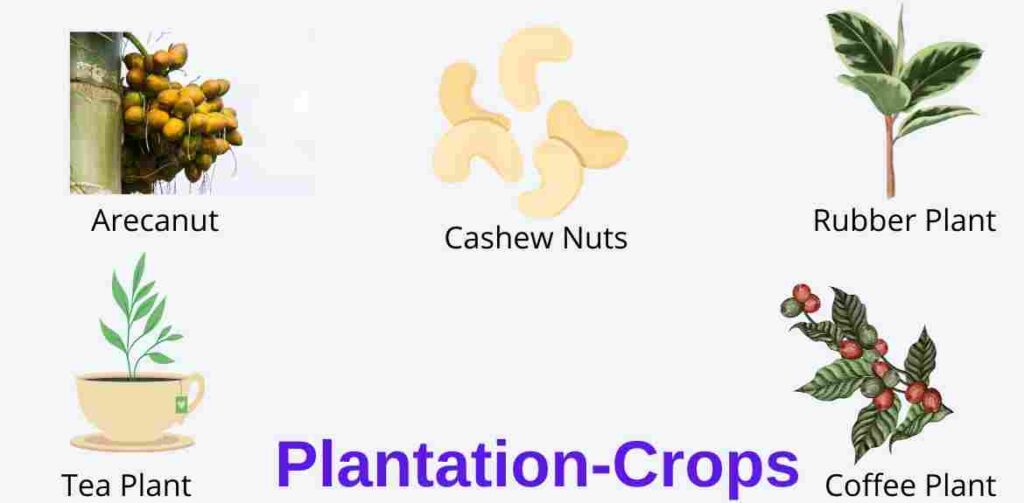Plantation Crop
Plantation Crops are the perennial commercial crops of tropical and subtropical climate which are cultivated on an extensive scale in contiguous areas managed by an individual or a company, requiring care throughout the year and the products of which are consumed only after processing. Some examples are: Tea, Coffee, Coca, Coconut, Cashews, Rubber Plant, Arecanut etc.

Many people have confusion between Fruit Crops and Plantation Crops. So, To clear that confusion, we have listed the differences between these two are:-
| Fruit Crops | Plantation Crops |
| They are directly consumed in fresh form. | They are consumed after processing only. |
| More Perishable | Less Perishable |
| They require more training and pruning. | They require less training and pruning. |
| They have less market value and are exported in less amount | They have high market value and are widely exported |
Also Read: Botanical Name Of Crops: Crop Scientific Name
10 Stunning Non Green Plants To Grow
Classification Of Plantation Crops
Plantation crops can be classified into 5 different groups:-
| 1. | Beverage Crops | Tea, Coffee Coca |
| 2. | Oil Yieding Crops | Coconut, Oil Palm, Palmyra Palm |
| 3. | Nuts | Cashew Nut |
| 4. | Industrial Crop | Rubber |
| 5. | Masticatory Crop | Arecanut, Beetle Vine |
➡️ Beverage Crops: The crops which products are used to make beverage other than water.
➡️Oil Yieding Crops: These crops are used to extract oil.
➡️Nuts: Nuts are dry single seeded fruits and have high oil content.
➡️ Industrial Crops: The crops which are used to make industrial products rather than consumption.
➡️ Masticatory Crops: Masticatory crops are used for chewing purposes.
In India, Plantation Crops are mainly confined to less populated South Indian states like Kerala, Karnataka, Tamil nadu, Andhra Pradesh and some North Indian states like Assam, Meghalaya and West Bengal.
These crops in India cover the area of 4 million hectares. It occupies 27% of total agricultural commodities and 4.8% of total export. India leads in production of Tea, Cashew, Arecanut, Coconut and Rubber.
Also Read: Famous Name For Different Crops
Characteristics Of Plantation Crops
- They are grown in large continuous areas.
- Crops have high market demand with good prices. Also, known as cash crops.
- They are perennial in nature.
- These crops are consumed only after processing.
- The return value (ROI) of these crops is high.
- They contribute to the national economy.
Also Read: Rabi And Kharif Crops In Pakistan
Importance Of Plantation Crops
1. High Value Crops
They are commercial crops grown for their high value products. They have demand in the market and are sold at high prices.
2. Export Potential
Many countries in the world export large amount of Plantation Crops Products. These products have high demand in international markets.
3. Industrial Importance
Plantation crops means they are consumed after processing. Industry does the job of processing which provides a way for industrial development. For example, Many tea industries are opening to make tea from tea leaves.
4. Employment Generation
Production of these crops requires labour for the whole season. This creates job opportunities for many people. For Example – In Kerela, coconut farming provides employment to 78 man days per hectare per year. Moreover, Industries required for the processing of these crops also creates employment opportunities for thousands of people.
5. Prevents Soil Erosion
These crops grown in hilly and slopes like Tea helps to prevent soil erosion. They also work as cover crops, So – Rain can’t wash away the soil.
Final Verdict
Plantation crops are very important for national and agriculture. The farming of these plants should be increased which can make country independent, and export of the country will increase. Hope this article clears the concept about these crops. If you have any questions, you can ask us from our contact us page.
Also Read: Planets In Order
